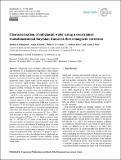Files in this item
Characterisation of subglacial water using a constrained transdimensional Bayesian transient electromagnetic inversion
Item metadata
| dc.contributor.author | Killingbeck, S. F. | |
| dc.contributor.author | Booth, A. D. | |
| dc.contributor.author | Livermore, P. W. | |
| dc.contributor.author | Bates, C. R. | |
| dc.contributor.author | West, L. J. | |
| dc.date.accessioned | 2020-01-24T09:30:04Z | |
| dc.date.available | 2020-01-24T09:30:04Z | |
| dc.date.issued | 2020-01-17 | |
| dc.identifier | 265961256 | |
| dc.identifier | e4012ca9-800f-4311-bd50-89892c2552bb | |
| dc.identifier | 85078295809 | |
| dc.identifier | 000508196900001 | |
| dc.identifier.citation | Killingbeck , S F , Booth , A D , Livermore , P W , Bates , C R & West , L J 2020 , ' Characterisation of subglacial water using a constrained transdimensional Bayesian transient electromagnetic inversion ' , Solid Earth , vol. 11 , pp. 75-94 . https://doi.org/10.5194/se-11-75-2020 | en |
| dc.identifier.issn | 1869-9510 | |
| dc.identifier.other | Bibtex: se-11-75-2020 | |
| dc.identifier.other | ORCID: /0000-0001-9147-7151/work/67919882 | |
| dc.identifier.uri | https://hdl.handle.net/10023/19347 | |
| dc.description | This research has been supported by the UK NERC SPHERES DTP (grant no. NE/L002574/1). Fieldwork was funded by the research project “Snow Accumulation Patterns on Hardangerjøkulen Ice Cap (SNAP)”, itself funded by the European Union’s Horizon 2020 project INTERACT, under grant agreement no. 730938. | en |
| dc.description.abstract | Subglacial water modulates glacier-bed friction and therefore is of fundamental importance when characterising the dynamics of ice masses. The state of subglacial pore water, whether liquid or frozen, is associated with differences in electrical resistivity that span several orders of magnitude; hence, liquid water can be inferred from electrical resistivity depth profiles. Such profiles can be obtained from inversions of transient (time-domain) electromagnetic (TEM) soundings, but these are often non-unique. Here, we adapt an existing Bayesian transdimensional algorithm (Multimodal Layered Transdimensional Inversion – MuLTI) to the inversion of TEM data using independent depth constraints to provide statistical properties and uncertainty analysis of the resistivity profile with depth. The method was applied to ground-based TEM data acquired on the terminus of the Norwegian glacier, Midtdalsbreen, with depth constraints provided by co-located ground-penetrating radar data. Our inversion shows that the glacier bed is directly underlain by material of resistivity 102 Ωm ± 1000 %, with thickness 5–40 m, in turn underlain by a highly conductive basement (100 Ωm ± 15 %). High-resistivity material, 5×104 Ωm ± 25 %, exists at the front of the glacier. All uncertainties are defined by the interquartile range of the posterior resistivity distribution. Combining these resistivity profiles with those from co-located seismic shear-wave velocity inversions to further reduce ambiguity in the hydrogeological interpretation of the subsurface, we propose a new 3-D interpretation in which the Midtdalsbreen subglacial material is partitioned into partially frozen sediment, frozen sediment/permafrost and weathered/fractured bedrock with saline water. | |
| dc.format.extent | 20 | |
| dc.format.extent | 29634656 | |
| dc.language.iso | eng | |
| dc.relation.ispartof | Solid Earth | en |
| dc.subject | GE Environmental Sciences | en |
| dc.subject | DAS | en |
| dc.subject.lcc | GE | en |
| dc.title | Characterisation of subglacial water using a constrained transdimensional Bayesian transient electromagnetic inversion | en |
| dc.type | Journal article | en |
| dc.contributor.institution | University of St Andrews. School of Earth & Environmental Sciences | en |
| dc.contributor.institution | University of St Andrews. Centre for Ancient Environmental Studies | en |
| dc.contributor.institution | University of St Andrews. Scottish Oceans Institute | en |
| dc.contributor.institution | University of St Andrews. St Andrews Sustainability Institute | en |
| dc.contributor.institution | University of St Andrews. Coastal Resources Management Group | en |
| dc.contributor.institution | University of St Andrews. Marine Alliance for Science & Technology Scotland | en |
| dc.identifier.doi | 10.5194/se-11-75-2020 | |
| dc.description.status | Peer reviewed | en |
This item appears in the following Collection(s)
Items in the St Andrews Research Repository are protected by copyright, with all rights reserved, unless otherwise indicated.

